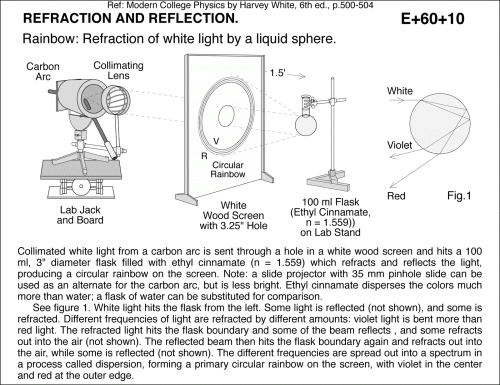Rainbow: Refraction of white light by a liquid sphere.
Primary tabs
Rainbow: Refraction of white light by a liquid sphere. Collimated white light from a carbon arc is sent through a hole in a white wood screen and hits a 100 ml, 3" diameter flask filled with ethyl cinnamate (n = 1.559) which refracts and reflects the light, producing a circular rainbow on the screen. Note: a slide projector with 35 mm pinhole slide can be used as an alternate for the carbon arc, but is less bright. Ethyl cinnamate disperses the colors much more than water; a flask of water can be substituted for comparison. See figure 1. White light hits the flask from the left. Some light is reflected (not shown), and some is refracted. Different frequencies of light are refracted by different amounts: violet light is bent more than red light. The refracted light hits the flask boundary and some of the beam reflects , and some refracts out into the air (not shown). The reflected beam then hits the flask boundary again and refracts out into the air, while some is reflected (not shown). The different frequencies are spread out into a spectrum in a process called dispersion, forming a primary circular rainbow on the screen, with violet in the center and red at the outer edge. Ref: Modern College Physics by Harvey White, 6th ed., p.500-504
UCB Index:
E+60+10
PIRA Index:
6A46.10
UCB Taxonomy:
PIRA Taxonomy:
Popularity:
- Log in to post comments

